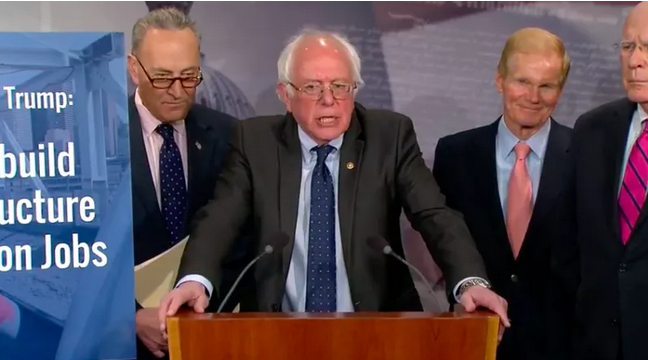Senator Bernie Sanders today released his plan for decarbonizing the American transportation system, calling for a big boost in transit spending, a network of high-speed rail, and a phasing out of internal-combustion engines.
The proposal, which he calls the Green New Deal, calls for moving toward 100 percent renewable energy for transportation by 2030 and complete decarbonization by 2050. The total price tag, the campaign estimates, is $16 trillion. The transition would create 20 million jobs, effectively ending unemployment, Sanders claims. Some are calling it the boldest plan by any Democrat seeking the presidency, and it is the first proposal from major contender that addresses transit.
But the document, while it promotes some good policies, is disappointingly vague in some areas and decidedly lackluster in others.
On transit and land use
The outline doesn't offer many details on transit and urban policy, focusing instead on targeting fossil-fuel companies and electrifying the vehicle fleet.
He does, however, propose $300 billion in investment in transit, with the goal of raising ridership by 65 percent by 2030. Toward this end, Sanders promises to promote transit-oriented development, but doesn't offer many specifics.
"For too long, government policy has encouraged long car commutes, congestion, and dangerous emissions," the campaign says in its outline. "The Green New Deal will reverse these trends and create more livable, connected, and vibrant communities."
It's good to see such rhetoric, but he does not flesh it out as well as he does some other aspects of his proposal. Even if we increased transit use 65 percent, that would still only get us to about 8 percent of commuting trips, well under current transit use in Canada.
The Intergovernmental Panel on Climate Change report estimates that, in order to avoid the worst consequences of climate change, about 20 percent of emissions reductions in transportation must come from "avoided trips" — forgoing car rides by walking, biking, switching to transit or staying home. Sanders's plan doesn't seem like it would get us there.
On vehicle electrification
The outline offers much more detail — and proposes to spend much more money — on an ambitious vehicle-electrification effort. Sanders proposes:
Creating a nationwide electric-vehicle-charging infrastructure at an estimated cost of $85.6 billion.
Establishing a $2.09 trillion (!!) grant program for low- and moderate-income families and small businesses to trade in used internal-combustion engine cars for new electric cars. The program would limit participants to electric vehicles built in America. Current vehicle-electrification subsidies have been criticized for being regressive, but Sanders says his plan would help further economic justice.
Electrifying school buses and city buses. Sanders says he would provide $407 billion in grants to electrify public and school bus fleets. Electrifying bus fleets is low-hanging fruit and a no-brainer win for the climate that should be happening faster, as Streetsblog has written.
Electrifying all freight trucks. Sanders proposes a $218 billion program in order to phase out internal-combustion-engine freight trucks in favor of electric ones. But with the problems associated with making and storing electric batteries, which use toxic metals, is all-in on electrification the way to go? And what about car-reduction strategies and biking? The document addresses neither.
High-speed rail
Sanders also proposes picking up the baton where Obama left off on high-speed rail. The Green New Deal calls for $607 billion for a "regional high-speed rail system" that it says would "complete the vision of the Obama administration."
Again, we don't have a lot of details here. Sanders has released only a broad outline. But his proposal for $607 billion in spending is much more ambitious than what Obama had to work with in 2010 (about $8 billion from the stimulus). Obama's efforts also were largely thwarted by hostile Republican governors.
It's not clear what the Sanders means by "regional high-speed rail." But the campaign links to this Obama-era map, showing routes that primarily connect major metropolitan areas, especially on the East Coast.
For roads
The plan positively fails when discussing road and highway infrastructure. Sanders says he supports another $75 billion for the National Highway Trust Fund — of which 80 percent of spending is for highways.
That might be fine if the plan specified the money would only be used for repair — not to expand highways that would increase sprawl, lengthen car commutes and cough more exhaust into the air. But it doesn't. It says, "Our national roads and highway system is crumbling," and simply calls for using the money to "improve roads, bridges, and other transportation infrastructure." Improve, in the highway-engineering world, is code for widen. Any new money to widen highways would almost certainly worsen carbon emissions.
The document is also, disappointingly, silent on complete streets and sidewalks.
On housing
Sanders goes pretty big in trying to address the housing-affordability crisis. He has proposed 7.5 million affordable housing units. He also proposes energy retrofits for the nation's public housing. But the document is mute on where all this new housing will be — and whether it will be transit accessible and walkable.
On oil
The plan goes for broke on restricting energy exploration and trade: Sanders proposes not only a ban new oil drilling, but also for banning imports and exports of fossil fuels. And it would end $15 billion in annual subsidies to oil companies.
The upshot
"This is a plan that goes all out for subsidizing EV purchases but lacks the same enthusiasm for local transit," said Ben Fried, a spokesperson for TransitCenter, a New York-based nonprofit organization that supports better transit. "The plank about transit does call for a significant increase in federal investment, but the proposed EV purchase and trade-in programs are 10 times larger than the proposed program for local transit."
In the end, we would have liked to see more fleshed-out urban-transportation-policy proposals — but it's good to see the candidate lay out plans for decarbonizing transportation.






